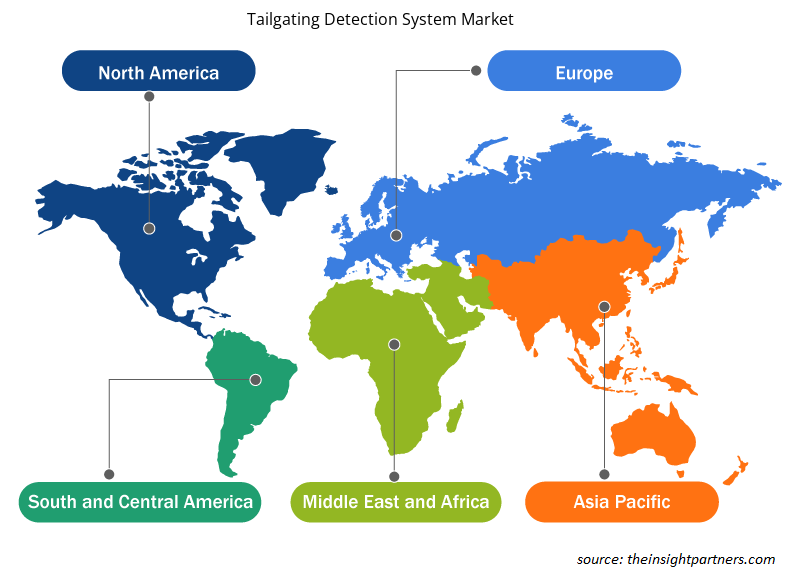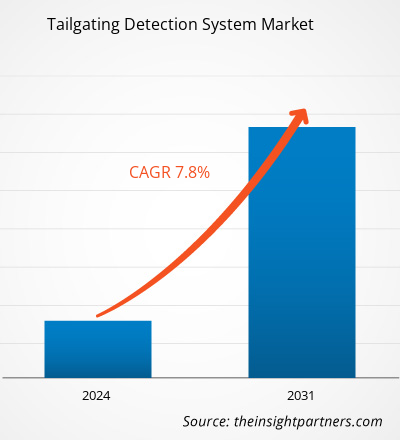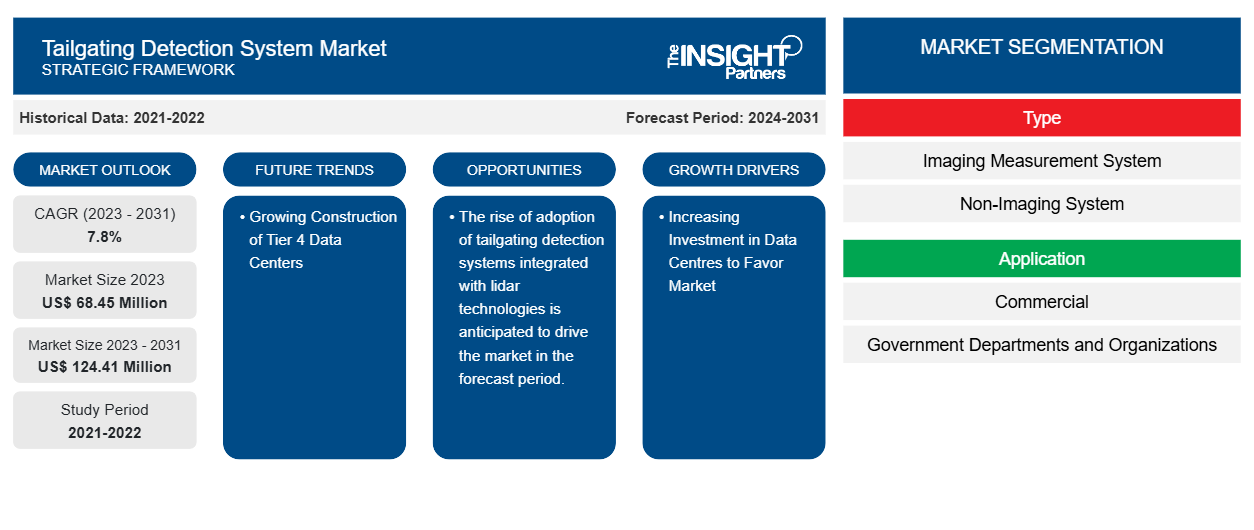Der Markt für Tailgating-Erkennungssysteme soll von 68,45 Millionen US-Dollar im Jahr 2023 auf 124,41 Millionen US-Dollar im Jahr 2031 anwachsen. Der Markt soll zwischen 2023 und 2031 eine durchschnittliche jährliche Wachstumsrate von 7,8 % verzeichnen. Die zunehmenden Investitionen in Rechenzentren und die Einführung von Tailgating-Erkennungssystemen zur Erkennung nicht autorisierter Fahrzeuge dürften die wichtigsten Treiber und Trends des Marktes sein.
Marktanalyse für Tailgating-Erkennungssysteme
Der Markt für Software für Tailgating-Erkennungssysteme verzeichnet weltweit ein erhebliches Wachstum. Dieses Wachstum ist auf Faktoren wie die zunehmenden Investitionen in Rechenzentren und die Einführung von Tailgating-Erkennungssystemen zur Erkennung nicht autorisierter Fahrzeuge zurückzuführen. Darüber hinaus fördert die zunehmende Implementierung künstlicher Intelligenz und maschinellen Lernens in Tailgating-Erkennungssystemen neben anderen Faktoren das Wachstum des Marktes für Handelsförderungsmanagement-Software.
Marktübersicht zu Tailgating-Erkennungssystemen
Es kommt zu Tailgating und vor unbefugtem Zutritt wird per Alarm und Warnlampe gewarnt. Dieses System kann die Nutzung vorhandener Einrichtungen und Zutrittskontrollsysteme optimieren und ermöglicht es Kunden, Kapitalinvestitionen zu reduzieren.
Passen Sie diesen Bericht Ihren Anforderungen an
Sie erhalten kostenlos individuelle Anpassungen an jedem Bericht, einschließlich Teilen dieses Berichts oder einer Analyse auf Länderebene, eines Excel-Datenpakets sowie tolle Angebote und Rabatte für Start-ups und Universitäten.
-
Holen Sie sich die wichtigsten Markttrends aus diesem Bericht.Dieses KOSTENLOSE Beispiel umfasst eine Datenanalyse von Markttrends bis hin zu Schätzungen und Prognosen.
Markttreiber und Chancen für Tailgating-Erkennungssysteme
Steigende Investitionen in Rechenzentren begünstigen den Markt
Die steigenden Investitionen in Rechenzentren treiben den Markt tatsächlich an. Mehrere Sensoren ermöglichen bessere Daten- und Authentifizierungsverfahren, die vieles übertreffen, was derzeit auf dem Markt erhältlich ist. Mit Alcatraz AI ist dreidimensionales Tracking und Tailgating-Prävention im Rechenzentrum garantiert. Darüber hinaus treiben die steigenden Investitionen das Marktwachstum an. So steht der indische Rechenzentrumssektor beispielsweise vor einer beeindruckenden Expansion, wobei Prognosen auf eine Kapazitätserweiterung von 791 MW bis 2026 hindeuten. Diese Expansion wird voraussichtlich einen Bedarf von 10 Millionen Quadratfuß Immobilienfläche ankurbeln und Investitionen in Höhe von insgesamt 5,7 Milliarden US-Dollar anziehen.
Zunehmender Bau von Tier-4-Rechenzentren.
Ein Tier-4-Rechenzentrum ist die höchste Zertifizierung im System des Uptime Institute zur Segmentierung der Rechenzentrumsleistung in vier Stufen. Diese Stufe geht mit einer erwarteten Betriebszeit von 99,995 % pro Jahr einher. Tier-4-Rechenzentren bieten das höchste Maß an Betriebszeit und Fehlertoleranz und sind daher ideal für unternehmenskritische Anwendungen wie Finanzdienstleistungen, Gesundheitswesen und Telekommunikation. Mit dem Wachstum dieser Sektoren und der fortschreitenden Digitalisierung steigt die Nachfrage nach Tier-4-Einrichtungen und treibt neue Bauprojekte voran.
Segmentierungsanalyse des Marktberichts zur Erkennung von Heckklappen
Wichtige Segmente, die zur Ableitung der Marktanalyse für Tailgating-Erkennungssysteme beigetragen haben, sind Typ und Anwendung.
- Basierend auf dem Typ wird der Markt für Tailgating-Erkennungssysteme in bildgebende Messsysteme und nicht bildgebende Systeme unterteilt. Das Segment der bildgebenden Messsysteme dürfte im Prognosezeitraum einen erheblichen Marktanteil halten.
- Basierend auf der Anwendung ist der Markt für Tailgating-Erkennungssysteme in kommerzielle und staatliche Abteilungen und Organisationen unterteilt. Es wird erwartet, dass das kommerzielle Segment im Prognosezeitraum einen erheblichen Marktanteil halten wird.
Marktanteilsanalyse für Tailgating-Erkennungssysteme nach geografischer Lage
Der geografische Umfang des Marktberichts zum Tailgating-Erkennungssystem ist hauptsächlich in fünf Regionen unterteilt: Nordamerika, Asien-Pazifik, Europa, Naher Osten und Afrika sowie Süd- und Mittelamerika.
Nordamerika dominiert den Markt für Tailgating-Erkennungssysteme. Die Einführung von Hochtechnologie in verschiedenen Branchen in der nordamerikanischen Region hat das Wachstum des Marktes für Tailgating-Erkennungssysteme vorangetrieben. Faktoren wie die zunehmende Einführung digitaler Tools und hohe Technologieausgaben von Regierungsbehörden, die zunehmenden Investitionen in Rechenzentren und die Einführung von Tailgating-Erkennungssystemen zur Erkennung nicht autorisierter Fahrzeuge werden voraussichtlich das Wachstum des nordamerikanischen Marktes für Tailgating-Erkennungssysteme vorantreiben. Darüber hinaus zwingt eine starke Betonung von Forschung und Entwicklung in den entwickelten Volkswirtschaften der USA und Kanadas die nordamerikanischen Akteure dazu, technologisch fortschrittliche Lösungen auf den Markt zu bringen. Darüber hinaus gibt es in den USA eine große Anzahl von Akteuren auf dem Markt für Tailgating-Erkennungssysteme, die sich zunehmend auf die Entwicklung innovativer Lösungen konzentrieren. All diese Faktoren tragen zum Wachstum des Marktes für Tailgating-Erkennungssysteme in der Region bei.
Regionale Einblicke in den Markt für Tailgating-Erkennungssysteme
Die regionalen Trends und Faktoren, die den Markt für Tailgating Detection Systems während des gesamten Prognosezeitraums beeinflussen, wurden von den Analysten von Insight Partners ausführlich erläutert. In diesem Abschnitt werden auch die Marktsegmente und die Geografie von Tailgating Detection Systems in Nordamerika, Europa, im asiatisch-pazifischen Raum, im Nahen Osten und Afrika sowie in Süd- und Mittelamerika erörtert.

- Erhalten Sie regionale Daten zum Markt für Tailgating-Erkennungssysteme
Umfang des Marktberichts zum Tailgating-Erkennungssystem
| Berichtsattribut | Details |
|---|---|
| Marktgröße im Jahr 2023 | 68,45 Millionen US-Dollar |
| Marktgröße bis 2031 | 124,41 Millionen US-Dollar |
| Globale CAGR (2023 - 2031) | 7,8 % |
| Historische Daten | 2021-2022 |
| Prognosezeitraum | 2024–2031 |
| Abgedeckte Segmente |
Nach Typ
|
| Abgedeckte Regionen und Länder |
Nordamerika
|
| Marktführer und wichtige Unternehmensprofile |
|
Dichte der Marktteilnehmer für Tailgating-Erkennungssysteme: Die Auswirkungen auf die Geschäftsdynamik verstehen
Der Markt für Tailgating Detection System wächst rasant, angetrieben durch die steigende Nachfrage der Endnutzer aufgrund von Faktoren wie sich entwickelnden Verbraucherpräferenzen, technologischen Fortschritten und einem größeren Bewusstsein für die Vorteile des Produkts. Mit steigender Nachfrage erweitern Unternehmen ihr Angebot, entwickeln Innovationen, um die Bedürfnisse der Verbraucher zu erfüllen, und nutzen neue Trends, was das Marktwachstum weiter ankurbelt.
Die Marktteilnehmerdichte bezieht sich auf die Verteilung der Firmen oder Unternehmen, die in einem bestimmten Markt oder einer bestimmten Branche tätig sind. Sie gibt an, wie viele Wettbewerber (Marktteilnehmer) in einem bestimmten Marktraum im Verhältnis zu seiner Größe oder seinem gesamten Marktwert präsent sind.
Die wichtigsten Unternehmen auf dem Markt für Tailgating-Erkennungssysteme sind:
- InfraRed Integrated Systems Ltd
- Kouba Systems Inc.
- Optex Co. Ltd
- Detex Corporation
- Optex Co., Ltd
- ACTi Corporation
Haftungsausschluss : Die oben aufgeführten Unternehmen sind nicht in einer bestimmten Reihenfolge aufgeführt.

- Überblick über die wichtigsten Akteure auf dem Markt für Tailgating-Erkennungssysteme
Marktnachrichten und aktuelle Entwicklungen zum Tailgating-Erkennungssystem
Der Markt für Tailgating-Erkennungssysteme wird durch die Erhebung qualitativer und quantitativer Daten nach Primär- und Sekundärforschung bewertet, die wichtige Unternehmensveröffentlichungen, Verbandsdaten und Datenbanken umfasst . Nachfolgend sind einige der Entwicklungen auf dem Markt für Tailgating-Erkennungssysteme aufgeführt:
- Optex Co., Ltd. (Hauptsitz: Otsu City, Präfektur Shiga, Präsident und CEO: Toru Kamimura) hat eine neue Tochtergesellschaft mit Sitz in den Niederlanden, Optex Security BV, gegründet, mit dem Ziel, den Geschäftsbetrieb in Europa zu stärken. (Quelle: Optex Co., Ltd. Unternehmenswebsite, Mai 2024)
Marktbericht zu Tailgating-Erkennungssystemen – Umfang und Ergebnisse
Der Bericht „Marktgröße und Prognose für Tailgating-Erkennungssysteme (2021–2031)“ bietet eine detaillierte Analyse des Marktes, die die folgenden Bereiche abdeckt:
- Marktgröße und Prognose für Tailgating-Erkennungssysteme auf globaler, regionaler und Länderebene für alle abgedeckten wichtigen Marktsegmente.
- Markttrends für Tailgating-Erkennungssysteme sowie Marktdynamik wie Treiber, Einschränkungen und wichtige Chancen.
- Detaillierte PEST/Porters Five Forces- und SWOT-Analyse.
- Analyse des Marktes für Tailgating-Erkennungssysteme, die wichtige Markttrends, globale und regionale Rahmenbedingungen, wichtige Akteure, Vorschriften und aktuelle Marktentwicklungen abdeckt.
- Branchenlandschaft und Wettbewerbsanalyse, einschließlich Marktkonzentration, Heatmap-Analyse, prominenten Akteuren und aktuellen Entwicklungen auf dem Markt für Tailgating-Erkennungssysteme.
- Detaillierte Firmenprofile.
- Historische Analyse (2 Jahre), Basisjahr, Prognose (7 Jahre) mit CAGR
- PEST- und SWOT-Analyse
- Marktgröße Wert/Volumen – Global, Regional, Land
- Branchen- und Wettbewerbslandschaft
- Excel-Datensatz
Aktuelle Berichte
Erfahrungsberichte
Grund zum Kauf
- Fundierte Entscheidungsfindung
- Marktdynamik verstehen
- Wettbewerbsanalyse
- Kundeneinblicke
- Marktprognosen
- Risikominimierung
- Strategische Planung
- Investitionsbegründung
- Identifizierung neuer Märkte
- Verbesserung von Marketingstrategien
- Steigerung der Betriebseffizienz
- Anpassung an regulatorische Trends























 Kostenlose Probe anfordern für - Markt für Tailgating-Erkennungssysteme
Kostenlose Probe anfordern für - Markt für Tailgating-Erkennungssysteme